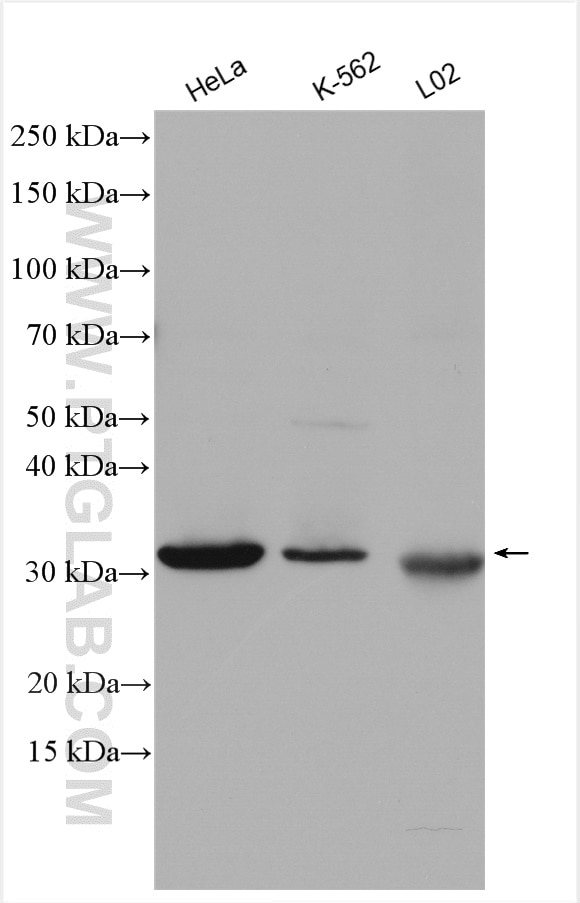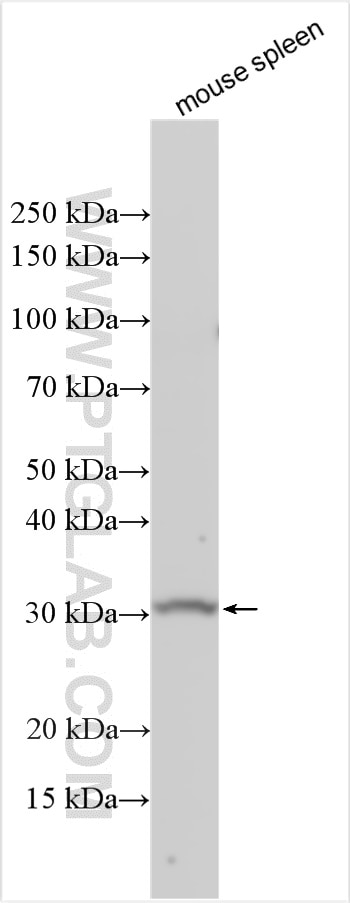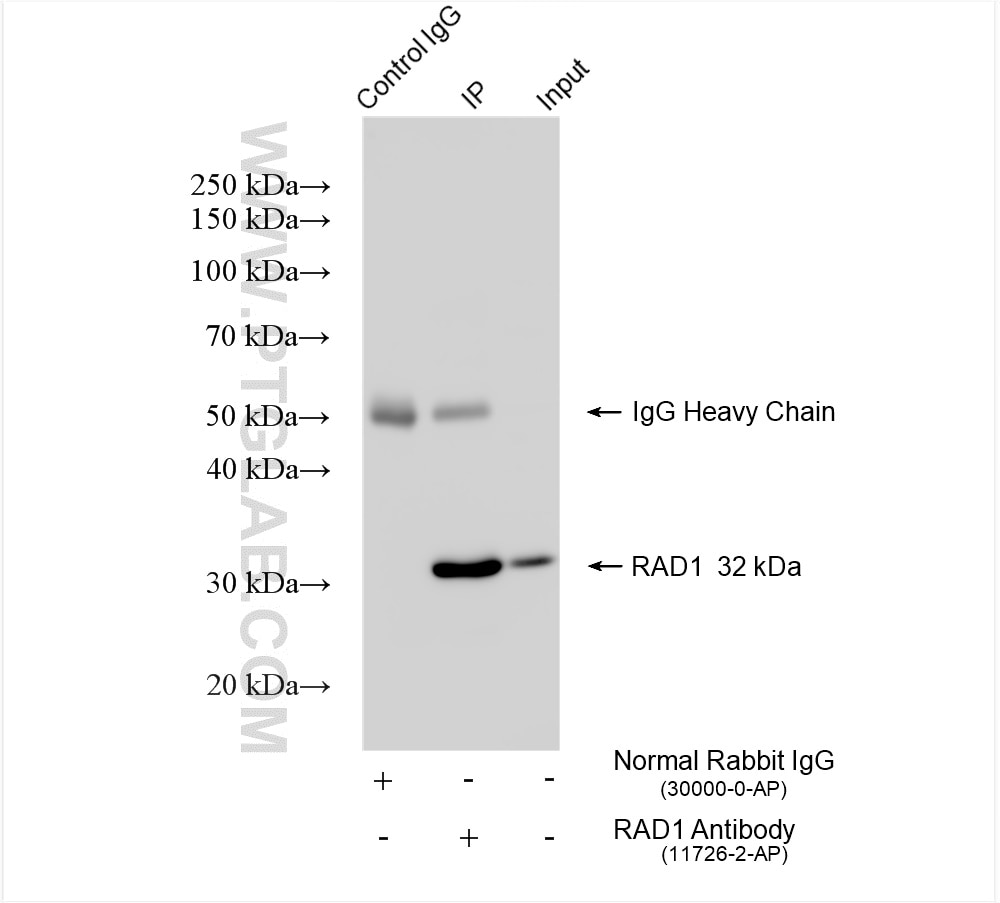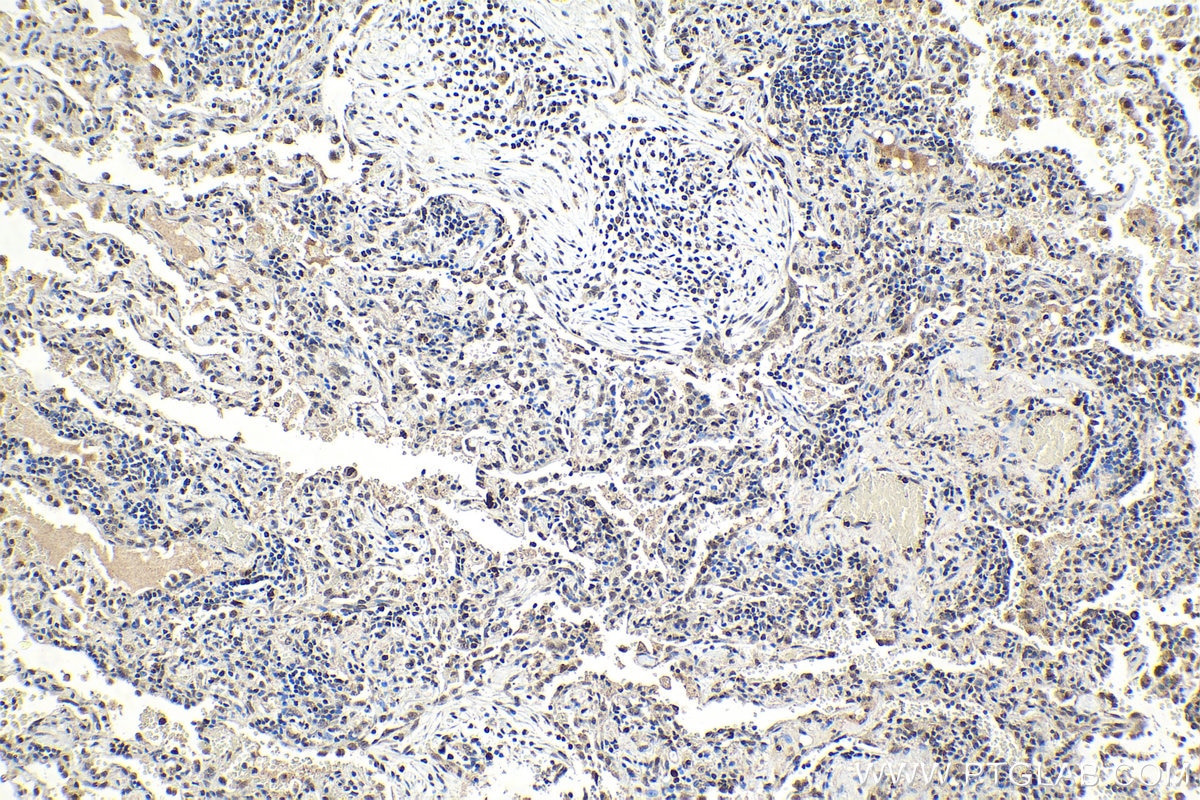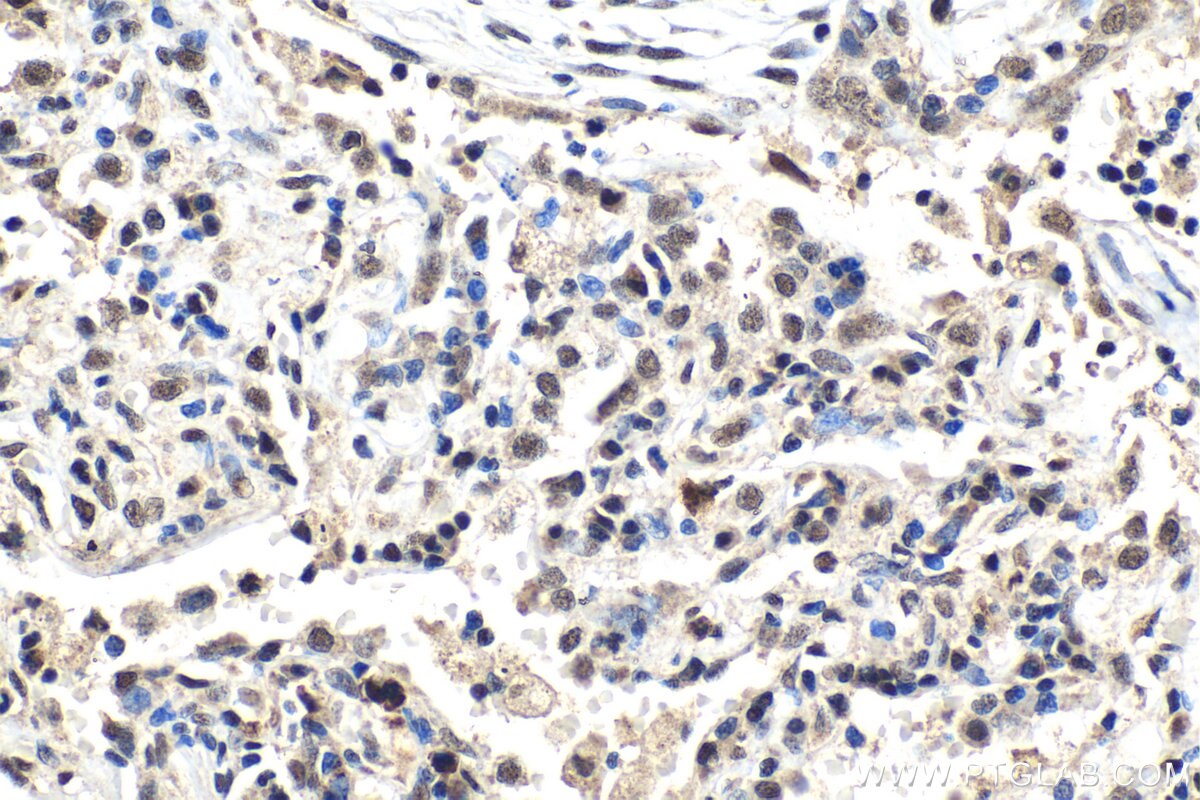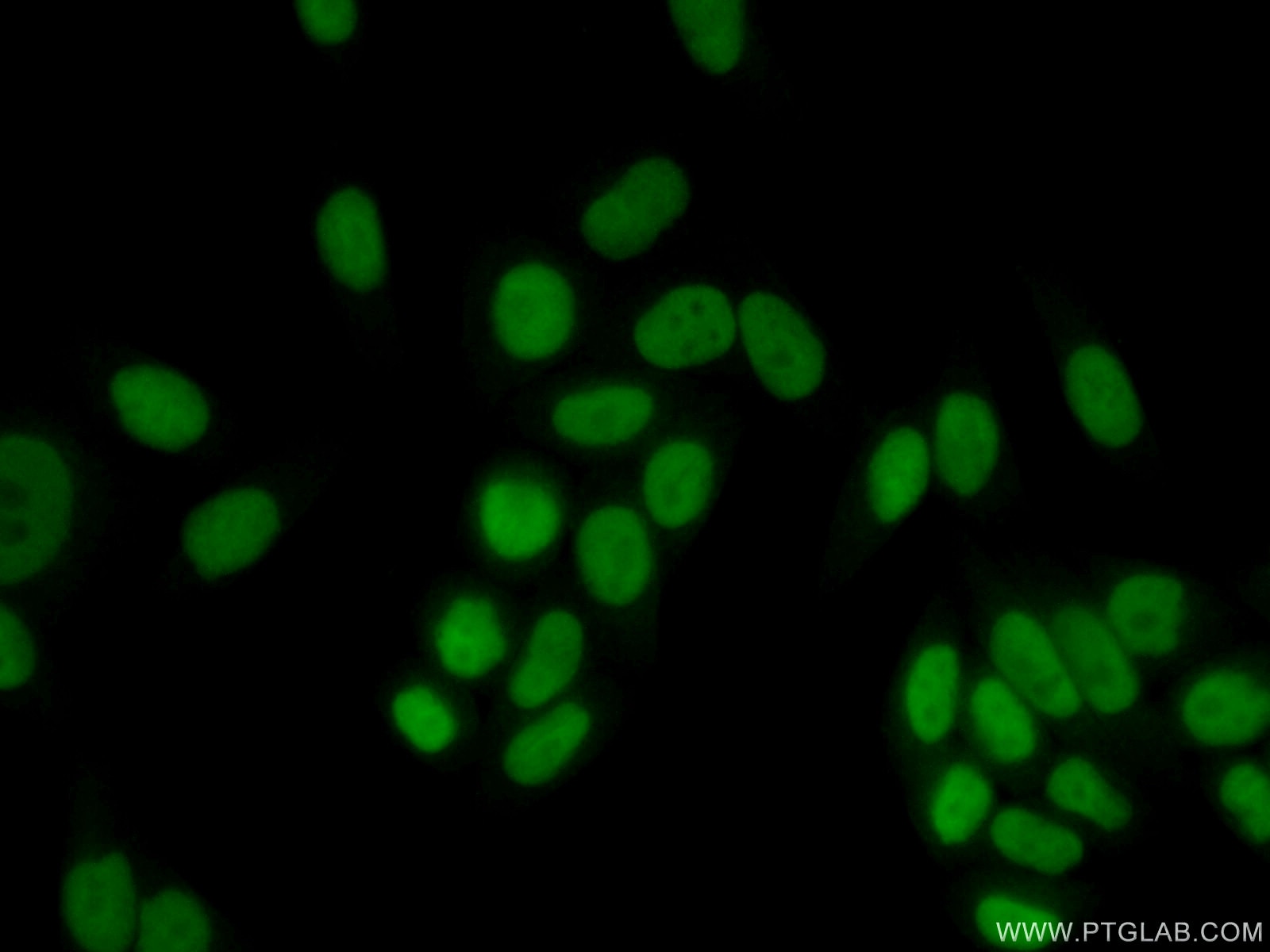Tested Applications
| Positive WB detected in | HeLa cells, mouse spleen tissue, K-562 cells, L02 cells |
| Positive IP detected in | HeLa cells |
| Positive IHC detected in | human lung tissue Note: suggested antigen retrieval with TE buffer pH 9.0; (*) Alternatively, antigen retrieval may be performed with citrate buffer pH 6.0 |
| Positive IF/ICC detected in | HeLa cells |
Recommended dilution
| Application | Dilution |
|---|---|
| Western Blot (WB) | WB : 1:500-1:3000 |
| Immunoprecipitation (IP) | IP : 0.5-4.0 ug for 1.0-3.0 mg of total protein lysate |
| Immunohistochemistry (IHC) | IHC : 1:500-1:2000 |
| Immunofluorescence (IF)/ICC | IF/ICC : 1:50-1:500 |
| It is recommended that this reagent should be titrated in each testing system to obtain optimal results. | |
| Sample-dependent, Check data in validation data gallery. | |
Published Applications
| WB | See 5 publications below |
Product Information
11726-2-AP targets RAD1 in WB, IHC, IF/ICC, IP, ELISA applications and shows reactivity with human, mouse samples.
| Tested Reactivity | human, mouse |
| Cited Reactivity | human, rat, rainbow trout |
| Host / Isotype | Rabbit / IgG |
| Class | Polyclonal |
| Type | Antibody |
| Immunogen |
CatNo: Ag2316 Product name: Recombinant human RAD1 protein Source: e coli.-derived, PGEX-4T Tag: GST Domain: 1-282 aa of BC006837 Sequence: MPLLTQQIQDEDDQYSLVASLDNVRNLSTILKAIHFREHATCFATKNGIKVTVENAKCVQANAFIQAGIFQEFKVQEESVTFRINLTVLLDCLSIFGSSPMPGTLTALRMCYQGYGYPLMLFLEEGGVVTVCKINTQEPEETLDFDFCSTNVINKIILQSEGLREAFSELDMTSEVLQITMSPDKPYFRLSTFGNAGSSHLDYPKDSDLMEAFHCNQTQVNRYKISLLKPSTKALVLSCKVSIRTDNRGFLSLQYMIRNEDGQICFVEYYCCPDEEVPESES Predict reactive species |
| Full Name | RAD1 homolog (S. pombe) |
| Calculated Molecular Weight | 32 kDa |
| Observed Molecular Weight | 32 kDa |
| GenBank Accession Number | BC006837 |
| Gene Symbol | RAD1 |
| Gene ID (NCBI) | 5810 |
| RRID | AB_2246457 |
| Conjugate | Unconjugated |
| Form | Liquid |
| Purification Method | Antigen affinity purification |
| UNIPROT ID | O60671 |
| Storage Buffer | PBS with 0.02% sodium azide and 50% glycerol, pH 7.3. |
| Storage Conditions | Store at -20°C. Stable for one year after shipment. Aliquoting is unnecessary for -20oC storage. 20ul sizes contain 0.1% BSA. |
Background Information
RAD1, cell cycle checkpoint protein, is a component of a heterotrimeric cell cycle checkpoint 9-1-1 complex, that is activated to stop cell cycle progression in response to DNA damage or incomplete DNA replication. RAD1, HUS1 and RAD9 are central components of a DNA damage-responsive protein complex. Testis-specific disruption of RAD1 in mice resulted in defective double-strand break repair, depletion of germ cells and infertility (PMID: 35133274). RAD1 has 3 isoforms produced by alternative splicing.
Protocols
| Product Specific Protocols | |
|---|---|
| IF protocol for RAD1 antibody 11726-2-AP | Download protocol |
| IHC protocol for RAD1 antibody 11726-2-AP | Download protocol |
| IP protocol for RAD1 antibody 11726-2-AP | Download protocol |
| WB protocol for RAD1 antibody 11726-2-AP | Download protocol |
| Standard Protocols | |
|---|---|
| Click here to view our Standard Protocols |
Publications
| Species | Application | Title |
|---|---|---|
Oncogene DNA damage-induced translocation of mitochondrial factor HIGD1A into the nucleus regulates homologous recombination and radio/chemo-sensitivity. | ||
J Mol Cell Biol SUMO-1 modification of FEN1 facilitates its interaction with Rad9-Rad1-Hus1 to counteract DNA replication stress. | ||
Am J Physiol Cell Physiol Succinylation at a key residue of FEN1 is involved in the DNA damage response to maintain genome stability. | ||
Comp Biochem Physiol C Toxicol Pharmacol The rad1 gene in Rainbow Trout (Oncorhynchus mykiss) is highly conserved and may express proteins from non-canonical spliced isoforms. | ||
Mol Med Rad1 attenuates DNA double-strand breaks and cell cycle arrest in type II alveolar epithelial cells of rats with bronchopulmonary dysplasia |

